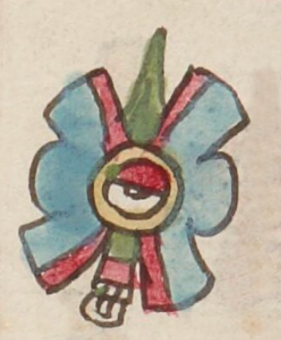olin (TR8v)
This simplex glyph for movement (olin) varies somewhat from the other olin glyphs in this collection. It has the quincunx X-shape with a round center that most others have, but it has a central shaft pointing upward. This shaft is something like the chalchihuitztli (a thorn decorated with a local jade bead). The shaft is mainly green. The colors of the rest of the olin are different from other glyphs in this collection. The X-shape of this olin is predominantly blue with a red inner lining. The inner circle is yellow with a red-and-white eye inside that. Like many others, outside the X, near where the lines cross, there are rounded protrusions. In other examples of olin, these rounded parts have a hole in the middle, somewhat reminiscent of the rings on a ball court. But there are no holes in these rounded bits.
Stephanie Wood
See James Maffie (Aztec Philosophy, 2014, 238–240) for a detailed discussion of the olin glyph and its iconography, drawing from a number of studies and contributing his own additional analysis. The four cardinal points are clearly represented, along with an important center, all linked to the motion of the sun. Motion-change is a key theme, especially as it relates to the changing ages or eras (culminating in the Fifth Sun). The olin glyph is especially prominent in scenes that include the Nahui Olin (4-Olin) date representative of this era. Some of these also have the starry or stellar eye at the center, such as the one carved into the drum of Malinalco. [See Símbolos de poder en Mesoamérica, ed. Guilhem Olivier (2008, 179), which republishes an image from Nicholson and Quiñones Keber, 1983).] This celestial connection again points to movements in the sky.
Olin is a day sign in the 260-day divinatory calendar (the tonalpohualli). This calendar was important in the Nahuas' religious views of the cosmos.
Stephanie Wood
ca. 1550–1563
Jeff Haskett-Wood
stellar eye, starry eye, eyes, ojos, estrellas, movimiento, puntos cardinales

ol(in), movement, earthquake, temblor, https://nahuatl.wired-humanities.org/content/olin
el movimiento
Stephanie Wood
Telleriano-Remensis Codex, folio 8 recto, MS Mexicain 385, Gallica digital collection, https://gallica.bnf.fr/ark:/12148/btv1b8458267s/f42.item.zoom
The non-commercial reuse of images from the Bibliothèque nationale de France is free as long as the user is in compliance with the legislation in force and provides the citation: “Source gallica.bnf.fr / Bibliothèque nationale de France” or “Source gallica.bnf.fr / BnF.”





